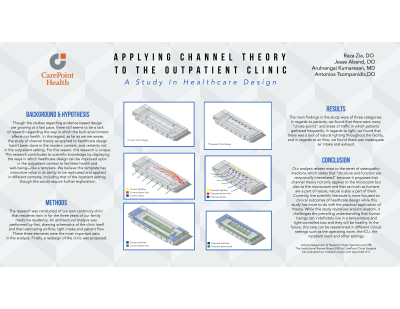Back

Clinical: General Topics
Applying Channel Theory to the Outpatient Clinic - a Study in Healthcare Design
Friday, March 31, 2023
12:00 PM East Coast USA Time

- RZ
Raza A. Zia, DO
Resident Physician
Christ Hospital at CarePoint Health
Bayonne, New Jersey, United States
Presenting Author(s)
Background and Hypothesis: Though the studies regarding evidence-based design are growing at a fast pace, there still seems to be a lack of research regarding the way in which the built environment affects our health. In this regard, as far as we are aware, the study of channel theory as applied to healthcare design hasn’t been done in the modern context, and certainly not in the outpatient setting. For this reason, this research is unique.
This research contributes to scientific knowledge by displaying the ways in which healthcare design can be improved upon in the outpatient context to facilitate health and well-being—like a template. We believe this template has instructive value in its ability to be replicated and applied in different contexts, including that of the inpatient setting, though this would require further exploration.
Methods: The research was conducted of our own continuity-clinic that residents train in for the three years of our family medicine residency. An architectural analysis was performed by first, drawing schematics of the clinic itself and then estimating air-flow, light intake and patient flow. These three elements were the most important data in the analysis. Finally, a redesign of the clinic was proposed.
Results: The main findings in the study were of three categories. In regards to patients, we found that there were many "choke-points" and areas of traffic in which patients gathered frequently. In regards to light, we found that there was a lack of natural lighting throughout the facility, and in regards to air flow, we found there was inadequate air intake and exhaust.
Conclusion: Our analysis relates most to the tenet of osteopathic medicine which states that “structure and function are reciprocally interrelated” because it proposes that channel theory not only applies to the microcosm but also to the macrocosm and that as much as humans are a part of nature, nature is also a part of them. Currently, the scientific literature is more focused on clinical outcomes of healthcare design while this study has more to do with the practical application of theory. While this study revitalizes ancient wisdom, it challenges the prevailing understanding that human beings can indefinitely live in a temperature and light-controlled box and they will be healthy. In the future, this case can be reexamined in different clinical settings such as the operating room, the ICU, the inpatient ward and other settings.
Acknowledgement of Research Study Sponsors and IRB: The Institutional Review Board (IRB) at CarePoint Christ Hospital has evaluated our research project and approved of it.
This research contributes to scientific knowledge by displaying the ways in which healthcare design can be improved upon in the outpatient context to facilitate health and well-being—like a template. We believe this template has instructive value in its ability to be replicated and applied in different contexts, including that of the inpatient setting, though this would require further exploration.
Methods: The research was conducted of our own continuity-clinic that residents train in for the three years of our family medicine residency. An architectural analysis was performed by first, drawing schematics of the clinic itself and then estimating air-flow, light intake and patient flow. These three elements were the most important data in the analysis. Finally, a redesign of the clinic was proposed.
Results: The main findings in the study were of three categories. In regards to patients, we found that there were many "choke-points" and areas of traffic in which patients gathered frequently. In regards to light, we found that there was a lack of natural lighting throughout the facility, and in regards to air flow, we found there was inadequate air intake and exhaust.
Conclusion: Our analysis relates most to the tenet of osteopathic medicine which states that “structure and function are reciprocally interrelated” because it proposes that channel theory not only applies to the microcosm but also to the macrocosm and that as much as humans are a part of nature, nature is also a part of them. Currently, the scientific literature is more focused on clinical outcomes of healthcare design while this study has more to do with the practical application of theory. While this study revitalizes ancient wisdom, it challenges the prevailing understanding that human beings can indefinitely live in a temperature and light-controlled box and they will be healthy. In the future, this case can be reexamined in different clinical settings such as the operating room, the ICU, the inpatient ward and other settings.
Acknowledgement of Research Study Sponsors and IRB: The Institutional Review Board (IRB) at CarePoint Christ Hospital has evaluated our research project and approved of it.
